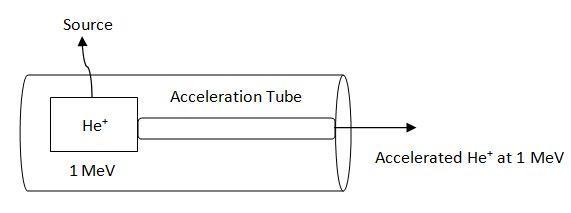| << Chapter < Page | Chapter >> Page > |
Helium ions not scattered at the surface lose energy as they traverse the solid. They lose energy due to interaction with electrons in the target. After collision the He particles lose further energy on their way out to the detector. We need to know two quantities to measure the energy loss, the distance Δt that the particles penetrate into the target and the energy loss ΔE in this distance [link] . The rate of energy loss or stopping power is a critical component in backscattering experiments as it determines the depth profile in a given experiment.
In thin film analysis, it is convenient to assume that total energy loss ΔE into depth t is only proportional to t for a given target. This assumption allows a simple derivation of energy loss in backscattering as more complete analysis requires many numerical techniques. In constant dE / dx approximation, total energy loss becomes linearly related to depth t, [link] .
The apparatus for Rutherford backscattering analysis of thin solid surface typically consist of three components:
There are two types of accelerator/ion source available. In single stage accelerator, the He + source is placed within an insulating gas-filled tank ( [link] ). It is difficult to install new ion source when it is exhausted in this type of accelerator. Moreover, it is also difficult to achieve particles with energy much more than 1 MeV since it is difficult to apply high voltages in this type of system.

Another variation is “tandem accelerator.” Here the ion source is at ground and produces negative ion. The positive terminal is located is at the center of the acceleration tube ( [link] ). Initially the negative ion is accelerated from ground to terminal. At terminal two-electron stripping process converts the He - to He ++ . The positive ions are further accelerated toward ground due to columbic repulsion from positive terminal. This arrangement can achieve highly accelerated He ++ ions (~ 2.25 MeV) with moderate voltage of 750 kV.

Particles that are backscattered by surface atoms of the bombarded specimen are detected by a surface barrier detector. The surface barrier detector is a thin layer of p-type silicon on the n-type substrate resulting p-n junction. When the scattered ions exchange energy with the electrons on the surface of the detector upon reaching the detector, electrons get promoted from the valence band to the conduction band. Thus, each exchange of energy creates electron-hole pairs. The energy of scattered ions is detected by simply counting the number of electron-hole pairs. The energy resolution of the surface barrier detector in a standard RBS experiment is 12 - 20 keV. The surface barrier detector is generally set between 90° and 170° to the incident beam. Films are usually set normal to the incident beam. A simple layout is shown in [link] .

Notification Switch
Would you like to follow the 'Physical methods in chemistry and nano science' conversation and receive update notifications?